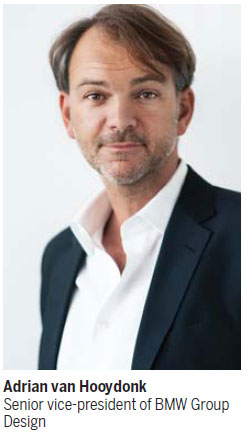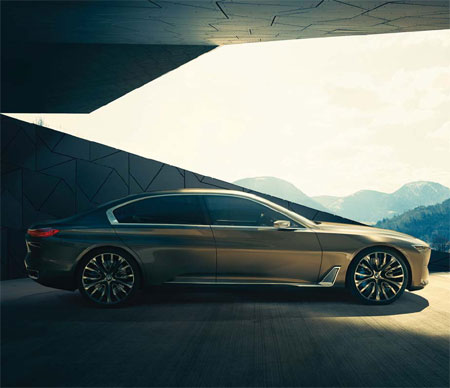BMW's DNA: Rich heritage, yet forward-looking design
(China Daily) Updated: 2014-04-20 07:57
Editor's Note: At the 2014 Beijing Auto Show, BMW showcased its full matrix of vehicles from the 1 series to 7 series, along with the Z and X family and the sub-brands BMW i and BMW M.
The premium carmaker also assigned a top-level expert team to Beijing that included the head of design. BMW designers are always superstars at auto shows for both the industry and public. China Daily interviewed Adrian van Hooydonk, senior vice-president of BMW Group Design, who sketched out BMW's design philosophy.
Q: Can you give a detailed explanation of your philosophy "progressive thinking with an open mind"?
A: All our brands have a very strong and rich design heritage and the design that we now do reflects that history.
You can recognize our past from our current design language at a glance, but we firmly believe that the modern technology that we produce today deserves a very forward-looking design, which is also easily identified from a modern BMW vehicle.
So for each of our brands, we are doing design that is authentic, true to our past, but definitely looking forward toward a high-tech future.
What are the current design philosophy and iconic design languages of BMW? Which BMW model is the best representative?
The design philosophy of the BMW brand is that we want to do design that expresses elegance, sportiness and modern luxury. Each of our cars expresses this in different ways. I would say that at the moment, the 7 series is the perfect example of that modern luxury with elegance, and the 6 series is a perfect example of our sportiness.
The new-generation BMW 7 series might come to the market in 2016. Can we expect a brand-new design interpretation with this all-new flagship model?
In every new car, of course we take our design language a step further, and also in every new car you can expect the very latest technology, so when the time comes to talk about the new 7 series, we can tell you more, but it's just a little bit too early right now.
With the concept vehicle BMW Vision Future Luxury, how do you portray the future premium market?
The Vision Future Luxury is full of ideas that we have for future luxury vehicles. So it is a vision car showing our interpretation, our ideas about modern luxury for the near future.
BMW says its i series stands for a sustainable mobility. What's your opinion on sustainability, and how do you meet the sustainable target from the design aspect?
BMW is the industry leader in the area of sustainable development. We are deeply involved in the issue of sustainability and have declared it as our major goal for the future.
Last year we launched the first electric car onto the market, the BMW i3, and this September the BMW i3 will hit the road in China.
With its innovative design and sustainable materials, we reached our sustainability target. For example, a wide range of natural materials are adapted to the interior of the i3, including naturally treated leather, wood, wool and other renewable raw materials, to ensure that the premium character of the BMW i3 - complemented by the added allure of impressive sustainability - is something you can both see and feel.
In addition, 25 percent (by weight) of the plastic used in the interior has been replaced with recycled or renewable raw materials.
Different countries have different cultures, so how do you mix the global universality of luxury in one BMW vehicle?
Aspects such as spaciousness or a passion for minute details are relevant to every country. But if we look at the Chinese market, for example, customers there insist on having red details in the car because that is their lucky color. Or they want special embroidery with symbols, like the horse edition of the 7 series.
If you go to the Middle East, there are other color preferences due to the lighting conditions there. But if we boil it down to the essentials, when it comes to this class of car, like the concept vehicle and the 7 series, everyone wants value retention and the meticulous, detailed premium quality, for which BMW is internationally renowned.
Apple rolled out CarPlay in Geneva, which illustrates a growing impact of the Internet world on the traditional auto business. How will BMW adapt the design philosophy to a more and more digitized world?
Customers expect more connectivity functions in our cars today. Our ConnectedDrive system enables our customers already in most BMWs to be connected to the Internet, and of course we will make sure that in all of our cars they will have the very latest connectivity possibilities in the future, whatever that entails. We do believe that there will be a lot of change in the user interface of cars in the near future, and that our customers of course will be able to use their personal communication devices seamlessly with our cars.
As you can see in our concept car, in the future we will have more of a digital interface. There will be more screens. We will have touch input as well, and this will make life onboard our vehicles a lot more comfortable, and there will be a new user interface that people can operate while driving.
A large part of this is the Head-Up Display - a technology that we were the first manufacturer to introduce in the premium segment.
I think we are still one of the very few car manufacturers to offer this. This helps you enjoy the drive and get the relevant information right in front of you projected out on the screen.
|
The BMW Vision Future Luxury shows some of the carmaker's ideas on tomorrow's vehicles. |


















